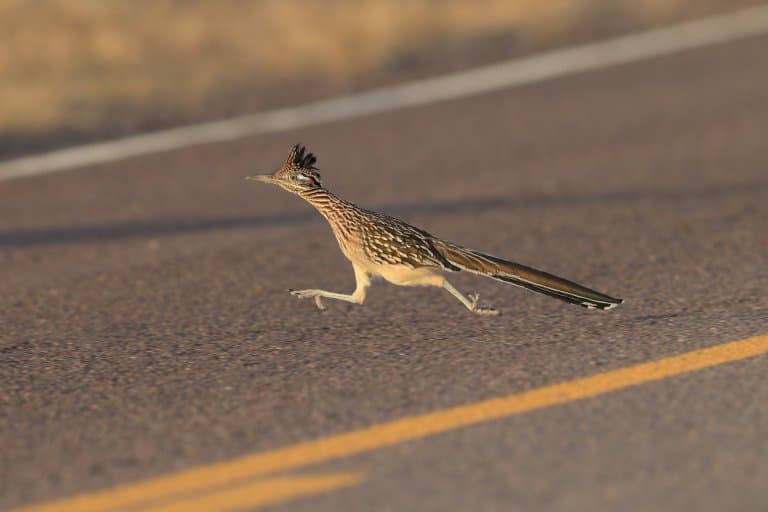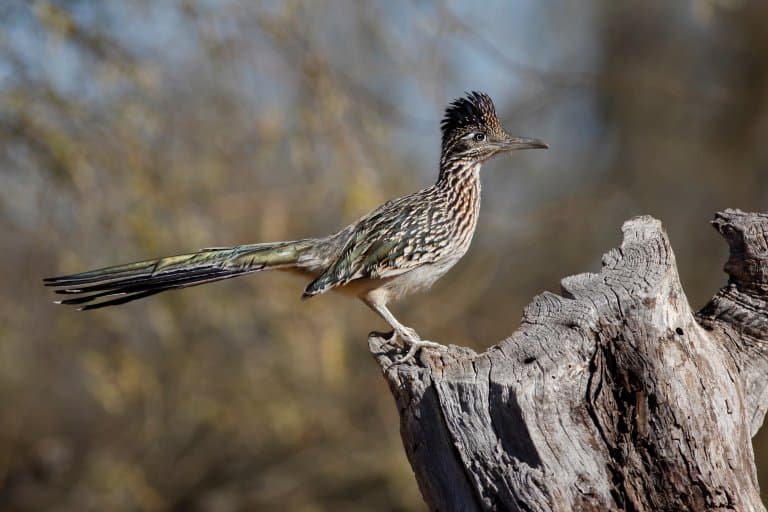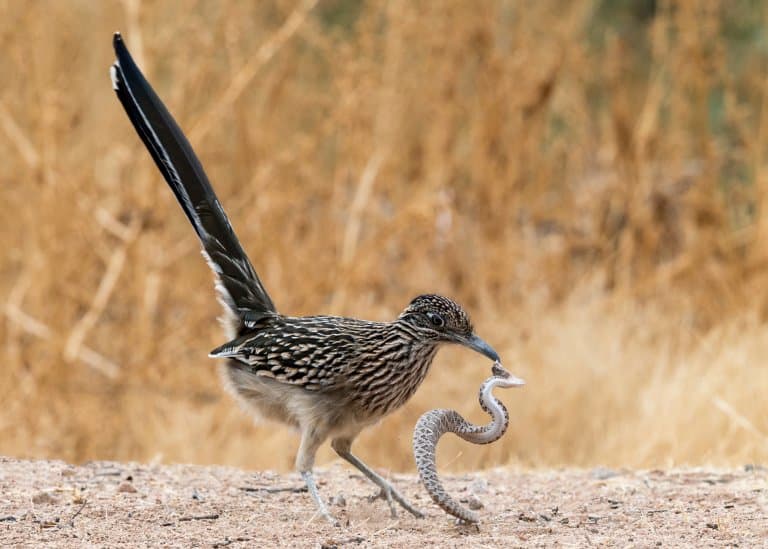Roadrunner Profile
In your best David Attenborough Voice: The great American deserts cover over two-and-a-half million square kilometres.
Here, few animals can survive the baking summer heat that has turned once-fertile soils into dry sand over tens of millions of years.
By 7 in the morning, the temperature is 25 degrees Celsius and amid the barren brush, a familiar call can be heard emanating from the ground.
A call from one of the most recognisable of the dinosaur descendants as it begins its daily routine:
Meep, meep.
It’s, a roadrunner. Roadrunners are two species of ground cuckoo birds also known as chaparral birds or chaparral cocks, that are extremely fast.
They are found in South USA, Mexico and Central America in desert regions.

Roadrunner Facts Overview
| Habitat: | Desert brush |
| Location: | Southwestern United States |
| Lifespan: | Up to around 8 years |
| Size: | Up to 61 cm (24 in) |
| Weight: | Usually around 430 g (15 oz) |
| Colour: | Speckled brown with lighter belly |
| Diet: | Opportunistic omnivore: insects, lizards, rodents, cactuses and sumacs |
| Predators: | Raccoons, hawks, coyotes (Wiley or otherwise). |
| Top Speed: | 32 km/h (20 mph) |
| No. of Species: | 2 |
| Conservation Status: | Least Concern |
Roadrunners are a nippy species of giant cuckoo with long tails and crests, which prefer to spend their time running, rather than flying.
They inhabit desert and arid regions, grasslands and woodlands. They will build nests from sticks in trees, bushes or cactus.
These are the largest of the cuckoos, but likely the most agile, and certainly so on land.
They’re fast, nimble, and are ferocious predators of some of the things that shouldn’t have predators at all! These highly-adapted desert runners are easy on the eye, too.
Interesting Roadrunner Facts
1. Ground cuckoos
Far from being just an ingredient in a witch’s burger recipe; New World ground cuckoos are also a subfamily of the infamous brood parasite whose call inspired the name: the cuckoo family, Cuculidae.
Ground cuckoos are a smaller group of 27 species, of which, roadrunners are two: the greater and lesser roadrunners.
But while they share the family with their somewhat unkind namesakes, these ones are a lot less infanticidal. 1
2. They’re not parasites!
Not all cuckoos trick silly birds into rearing their young. Roadrunners are a great example of an independent bird, who builds its own nest and rears its own children.
A pair of roadrunners will nest 1-3 meters off the ground, in the shade, usually on a horizontal branch or robust cactus.
They’ll even have a driveway, or a road that leads up to the nest, chosen specifically, or carved out by their trips to pick up resources. In greater roadrunners, males will gather the wood for building, and females will meticulously arrange them into small cupped nests.
This arrangement works well, but sometimes the male will need reminding of his task, which comes in the form of a whining call from his mate.
Up to six eggs can be laid in this nest, and will be incubated for only 19-20 days. Newly-hatched chicks are not able to see, but are immediately strong and active. 2
3. They’re lovers
Like slinkies, Roadrunners travel alone or in pairs, and breeding couples are life-long monogamists. They will hold a territory all year and courtship involves some very sophisticated bows and salutes.
Males will also offer food to the female, in the hopes she’ll be persuaded to put out. Incidentally, this is a very successful human strategy too.
4. They’ve got weird feet
Zoologists have loads of words for the arrangements of toes and so rarely get to use them in polite conversation, so roadrunners are an excellent opportunity to show off.
Roadrunners leave little X-shaped footprints in the sand, and this is because their tows are arranged in a form known as Zygodactyly.
Some birds and chameleons exhibit this arrangement, it’s essentially the splitting of the hand into two front-facing toes and two backward-facing ones. It’s great for climbing, hence why chameleons have it, and shows up in some perching birds like parrots, woodpeckers, and… cuckoos.
Roadrunners don’t perch much, but they’re stuck with the feet anyway, and it might actually be quite useful for agility and dexterity while running.

5. They can sprint over 30 kph (20 mph)
Their feet certainly don’t slow them down, anyway. Roadrunners can sprint at 32 km/h, using their tail as a rudder to change direction quickly.
They can fly, they just don’t, much. Instead, the forage on the ground, taking advantage of anything small enough to eat.
They’re so competent on the ground that even predators will rarely elicit a jump or a flap, though these birds are capable of it if they need to, and are quite confident in the air, too.
Their heavier bodies are certainly better adapted for life on land, but they’re still strong enough to catch insects on the wing, too. 3 4
6. They eat rattlesnakes
This agility opens up a lot of doors for the bird, which is speedy enough to take on rodents, lizards and small mammals for dinner. These are all ceremoniously smashed on a rock or the ground to tenderise them before swallowing.
Thy can even catch bats and birds, but being omnivorous, they’ll make do with seeds and fruit if animal protein is scarce.
Even rattlesnakes are on the menu, and can be dispatched in a similar bludgeoning fashion, after which it will be consumed, not all at once, but some length at a time, digesting one end while the remainder hangs from the bird’s mouth as a message to the other snakes in the area.
Tarantula hawk wasps are another animal that think they’re at the top of the food chain until roadrunners show up, as this bird is one of the few predators brave enough to eat one.

7. They can go into torpor
The midday temperature in the roadrunners’ region can exceed 40 degrees Celcius, so even if they were able to handle it, they’d have a hard time finding any prey animals out at that time.
Instead, these diurnal birds hunt in the mornings and evenings, adapting their behaviour to their extreme environment.
But they have a physiological adaptation to desert life, too. As the scorching heat of the day is replaced by frigid night-time temperatures, these birds enter a sort of hibernation state. This state, or torpor, slows down the metabolism of the animal, and lets them conserve energy at a lower body temperature, rather than using more energy trying to keep the body warm.
Conversely, the roadrunner has heat-absorbing dark patches on its body that can be used to absorb the early morning warmth to get back up to running temperatures again the next day.
8. They can go a lifetime without water
Birds are experts in conserving water.
Along with mammals, they’re the only animals capable of concentrating urine, and this helps them reduce the water they need, thus reducing their weight and making flight a heck of a lot easier – even if they choose not to fly much.
These birds can go an entire lifetime without drinking water (technically, so can everything else, but at least in roadrunners that lifetime isn’t reduced by it), and get their moisture entirely from their diets.
9. The greater roadrunner is the state bird of New Mexico
The Greater Roadrunner is found across the American southwest and south central regions, as well as south to central Mexico.
Early settlers in New Mexico were told that “if you got lost, a roadrunner would always lead you back to the path for which you were searching”, while native Americans believe that the spirit of the bird has supernatural powers. 5

10. They are not as fast as a coyote as popularised by the cartoon
The roadrunner was popularised by the Warner Bros. cartoon ‘Road Runner’, with the characters Wile E. Coyote, and the Road Runner.
While the cartoon popularised the myth that roadrunners can outpace a coyote, in fact the coyote’s are capable of running up to 64 km/h (40 mph), which is faster than the roadrunner’s 32 km/h (20 mph).
Roadrunner Fact-File Summary
Scientific Classification
| Kingdom: | Animalia |
| Phylum: | Chordata |
| Class: | Aves |
| Order: | Cuculiformes |
| Family: | Cuculidae |
| Subfamily: | Neomorphinae |
| Genus: | Geococcyx |
| Species: | Geococcyx Californianus Geococcyx Velox |
Fact Sources & References
- BBC Earth (2023), “Roadrunner’s Race Against Time”, YouTube.
- “Greater Roadrunner”, All About Birds.
- “Greater roadrunner”, National Geographic.
- “ROADRUNNER”, Zoo New England.
- “State Bird”, New Mexico Secretary of State.
